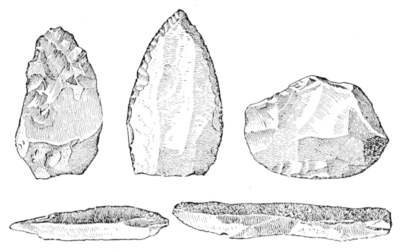Stone Age; the following one as the Neolithic or New Stone Age; and the later period as the Age of Metals.
The division lines between these ages are not sharply drawn. In most countries the epochs run into and overlap one another, just as in modern times the Age of Steam runs into and overlaps the Age of Electricity.
5. The Paleolithic or Old Stone Age.—In the Old Stone Age man's implements were usually made of stone, and particularly of easily chipped flints, though sometimes bones, horns, tusks, and other material were used in their manufacture. These rude tools and weapons of Paleolithic man, found in gravel beds and in caves, are the very oldest things in existence shaped by human hands.
Fig. I.—The Earliest Implements of Paleolithic Type.[1] (After Wilson)
The man of the Old Stone Age saw the retreating glaciers of the last great ice age, of which geology tells us. Among the animals which lived with him on the continent of Europe—we know most of Paleolithic man there—were the mammoth, the cave bear, the elk, the rhinoceros, the wild horse, and the reindeer; species which are no longer found in the regions where primitive man hunted them. As the climate gradually grew warmer they either became extinct or retreated up the mountains or migrated towards the north.
What we know of Paleolithic man may be summed up as follows: he was a hunter and fisher; his habitation was a cave or a rock shelter; his implements were in the main roughly
- ↑ These objects come from France. The central flint in the upper row is especially interesting as being "undoubtedly the ancestor or forerunner of all arrow or spear heads" (Wilson). Of equal interest is the scraper (the upper right-hand flint) as "marking the first step taken by man in the art of tanning, and as being the oldest specialized tool or utensil known to him" (Ibid.).

